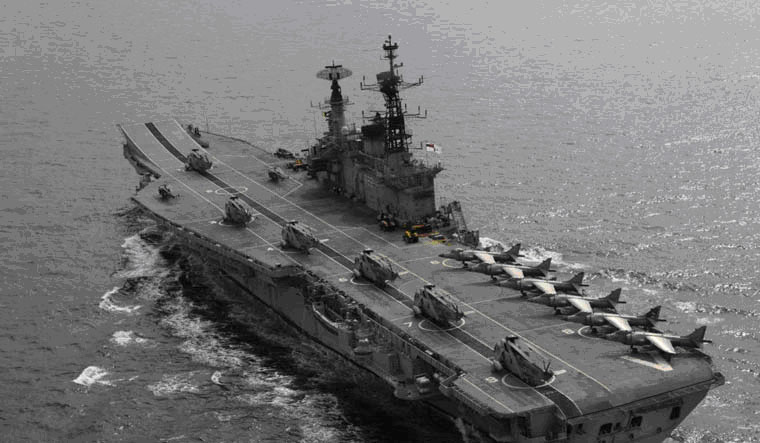Why A British Veteran Wants To Save An Indian Aircraft Carrier From Scrap Yard
By Justin Paul George
Viraat entered service with the Indian Navy in 1987 after 25 years in the Royal Navy
August 26, 2020
On Tuesday, a scrapping company announced that the Indian Navy’s second aircraft carrier, INS Viraat, will be towed from Mumbai to a ship-breaking yard in Alang, Gujarat, next month.
The announcement has come as a disappointment for a group of British Royal Navy veterans, who were campaigning to preserve the ship.
The INS Viraat entered service with the Indian Navy in 1987 after serving 25 years in the Royal Navy, which had christened the ship HMS Hermes. The Hermes/Viraat was a historic ship for many reasons, one being the fact that its construction at Barrow in the UK began in 1944, during the Second World War. This made it the world’s oldest aircraft carrier at the time of its decommissioning by the Indian Navy in 2017.
The Hermes entered Royal Navy service in 1959 and saw multiple ‘facelifts’: Fitting of steam catapult to launch fighters, removal of these catapults and fighter jets in the 1970s to carry helicopters to deploy troops and, finally, modification to launch the legendary Harrier ‘jump jet’ fighter. During the ship’s time as a helicopter carrier, a notable crewmember was Prince Charles, who served as a helicopter pilot.
The finest hour for the HMS Hermes came in 1982, when the ship led the Royal Navy task force that ended the Argentine invasion of the Falkland Islands. The Hermes’s importance for the Royal Navy in the Falklands War cannot be understated and earned the ship an iconic status in modern British naval history. British admiral John Forster ‘Sandy’ Woodward, who led the Falklands War task force, admitted losing the Hermes would have doomed the British campaign. In his book, One Hundred Days: The Memoirs of the Falklands Battle Group Commander, Woodward notes “…the Argentine commanders failed inexplicably to realise that if they had hit Hermes, the British would have been finished. They never really went after the one target that would surely have given them victory.”
It is this reputation that compelled Andy Trish, a British information technology entrepreneur, to launch multiple efforts to preserve the Viraat. In 2019, Trish had announced plans to raise around $25 million to tow the Viraat back to the UK and turn it into a museum. Trish has a special bond with the ship: He had served on the Hermes as a 19-year-old naval airman during the Falklands War.
In an interview with THE WEEK, Trish said a group of veterans are “trying to campaign [Prime Minister Narendra] Modi to block the scrapping as a last resort”.
Trish said veterans from the UK had formed the Hermes Viraat Heritage Trust to purchase the Viraat and “transform her in to a museum showing all aspects of her life in the UK and India”. “The trust has many veterans from both countries following their actions and we have interested investors wanting to save the ship. We all see this as a viable commercial project that would not only be profitable but would also cater for employing UK and Indian veterans and providing event and conference facilities for Indian celebrations and historic purposes. Unfortunately, it appears her future had been decided long ago,” Trish said.
He said around 2,500 veterans in the UK want to see the Viraat saved from scrapping and noted “I imagine there are many more in India who would join us”.
Trish talked to THE WEEK about his time on the Hermes, the ship’s legacy and veterans’ desire to save her:
- What are your memories of the HMS Hermes?
I served on board HMS Hermes for only two years, 1981-82; she was not just a ship, she was home. As a young man, she took me on my first trips oversea, then to war and back again.
- How important a role did the Hermes play in the Falklands War?
As one of just two Royal Navy aircraft carriers, she facilitated the airstrikes during the Falklands War. Without her, it was game over.
- What memories of the Falklands War stay with you the most?
Being told my brother’s ship (HMS Antelope) had been sunk, and not knowing whether he was alive or dead. I was told many days later he had survived and was on his way home.
- The Hermes saw multiple modifications. What explains this level of versatility for a ship launched during World War 2?
Known as the ‘Happy H’ by her crew, she was built by designers who understood the roles she would, may be, encounter during her service. The crew helped make the ship what she was, but it was the ship that helped make the crew happy.
- You were involved in campaigns to buy and preserve the Viraat. What prompted you to make such moves?
Until the latest announcement, I was still very much involved in saving her as a museum. The world’s longest-serving aircraft carrier deserves recognition for her achievements and could still have a long life ahead of her, if it hadn’t been for someone in India who just wanted her gone. We could still now raise the funds to save her if only the Indian Government would give us the opportunity.
- What do you make of the Indian Navy’s handling of the vessel during its 30-year service?
I was invited on board for her decommissioning and it was like being home again. The Indian Navy had done us proud, keeping her in fantastic condition.
Courtesy: Opera News/The Week

